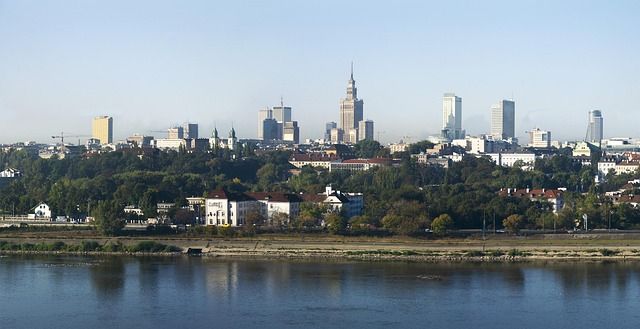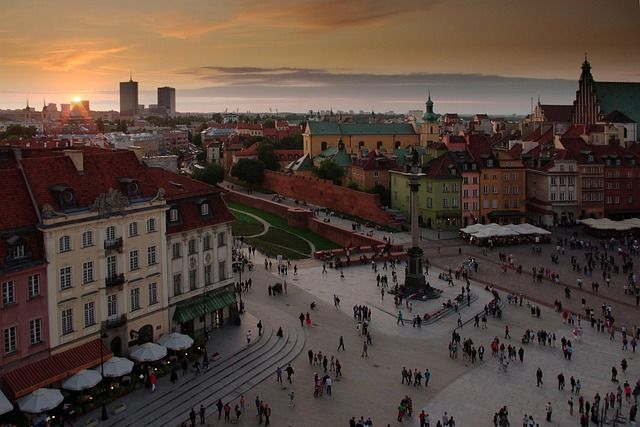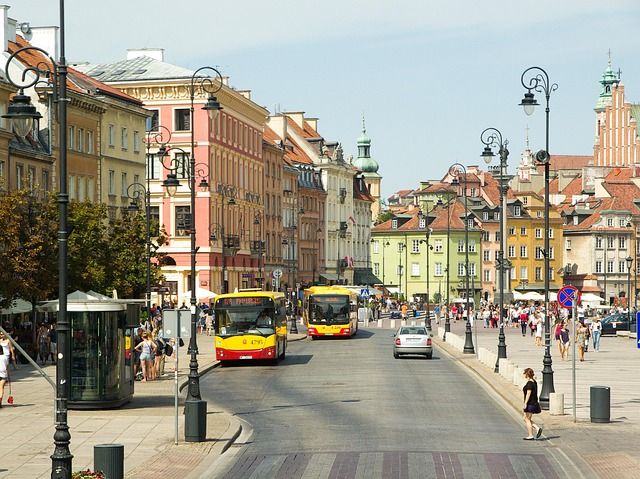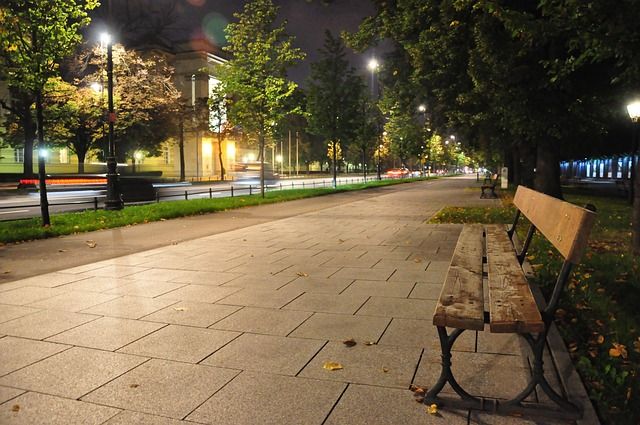
VERSIÓN ESPAÑOL:
¿Cómo va la gente de Blurt?
Les aúllo el chisme por el que seguro vienen a leer a mi cueva de meditación:
Varsovia es una ciudad que respira historia en cada una de sus calles, una mezcla de cicatrices y resiliencia que la han convertido en lo que es hoy. Caminar por su casco antiguo, meticulosamente reconstruido tras la Segunda Guerra Mundial, es como recorrer las páginas de un libro que narra siglos de lucha, esplendor y renacimiento.
Su origen se remonta a la Edad Media, cuando era solo un pequeño asentamiento a orillas del Vístula. Con el tiempo, el crecimiento de la ciudad la convirtió en un punto clave para el comercio y la política de la región. En el siglo XVI, Varsovia fue elegida como capital de la Mancomunidad Polaco-Lituana, desplazando a Cracovia en importancia y estableciendo el camino para su desarrollo como el corazón de Polonia.

Sin embargo, la historia de Varsovia no es solo una de progreso, sino también de destrucción y reconstrucción. Durante la Segunda Guerra Mundial, la ciudad quedó reducida a escombros tras el Levantamiento de Varsovia de 1944, un acto de resistencia heroico pero brutalmente sofocado por las fuerzas nazis. Lo que siguió fue una de las reconstrucciones más impresionantes de la historia moderna, basada en antiguos grabados y pinturas para devolverle su esplendor.
Hoy, Varsovia es una capital vibrante, donde lo antiguo y lo moderno conviven en perfecta armonía. Sus edificios históricos reconstruidos contrastan con rascacielos contemporáneos, mientras sus calles bulliciosas reflejan la energía de una ciudad que nunca dejó de reinventarse.

Varsovia es una ciudad que sorprende a cada paso, un destino que quizás no siempre encabeza las listas de turismo europeo, pero que tiene todo para cautivar a quienes se aventuran a descubrirla. Su historia, marcada por el resurgimiento y la resistencia, le ha dado un carácter único que se refleja en su arquitectura, su cultura y el ritmo vibrante de sus calles.
Uno de los mayores atractivos es su casco antiguo, declarado Patrimonio de la Humanidad por la UNESCO. Aunque su apariencia medieval pueda engañar, cada piedra y cada fachada fueron meticulosamente reconstruidas después de la Segunda Guerra Mundial, basándose en viejas pinturas y documentos históricos. Pasear por sus calles adoquinadas es como viajar en el tiempo, con la majestuosa Plaza del Mercado y el imponente Castillo Real recordando la época en la que Varsovia era el centro del poder.
Más allá de su historia, la ciudad es un mosaico de contrastes. El barrio de Praga, al otro lado del Vístula, ofrece una visión más alternativa y bohemia, con arte callejero, galerías independientes y un ambiente creativo que ha convertido antiguas fábricas en espacios culturales. Al mismo tiempo, el modernismo se abre paso en el centro financiero con sus rascacielos, destacando el emblemático Palacio de la Cultura y la Ciencia, un regalo de la Unión Soviética que sigue siendo uno de los puntos más reconocibles del skyline varsoviano.

Pero Varsovia no solo se descubre a través de sus edificios, sino también de su ambiente. Sus cafés y bares, muchos escondidos en patios interiores, invitan a disfrutar de una gastronomía que fusiona tradición y modernidad, desde el clásico pierogi hasta platos innovadores que reflejan la nueva identidad culinaria del país.
El legado de la música también resuena en cada rincón, con la figura de Chopin omnipresente en bancos musicales que reproducen sus melodías y conciertos gratuitos en el Parque Łazienki durante el verano. Y para los amantes de los museos, la oferta es inagotable, desde el conmovedor Museo del Levantamiento de Varsovia hasta el moderno POLIN, que narra la historia de los judíos polacos a lo largo de los siglos.
Varsovia no es una ciudad que se conforma con su pasado, sino que lo lleva consigo mientras se transforma en un destino dinámico, innovador y lleno de vida. Es un lugar que atrapa, no por la perfección de sus postales, sino por la autenticidad de su historia y la energía de su presente.

La experiencia de conocer Varsovia no está completa sin sumergirse en su gastronomía, una mezcla de tradición y evolución que refleja la historia y el carácter de la ciudad. La comida polaca es reconfortante, abundante y llena de sabores que han sido moldeados por siglos de influencia eslava, judía y centroeuropea.
Uno de los platos más emblemáticos es el pierogi, esas pequeñas empanadas de masa blanda rellenas de todo tipo de ingredientes, desde el clásico de patata y queso (ruskie) hasta los de carne, setas o incluso versiones dulces con frutos rojos. Se pueden encontrar en casi cualquier restaurante de comida tradicional y hasta en versiones más modernas en locales de cocina creativa.
Otro imperdible es el żurek, una sopa ácida y espesa preparada con harina de centeno fermentada, servida con huevo duro y salchicha ahumada. Es un plato con una profundidad de sabor sorprendente, perfecto para los días fríos y muy representativo de la cocina polaca.

El bigos, conocido como el "guiso de los cazadores", es otro clásico. Se trata de una mezcla de chucrut, repollo fresco y carne de cerdo, a menudo cocinada durante días para intensificar su sabor. Es un plato que cambia de gusto con el tiempo, pues cuanto más tiempo reposa, mejor sabe.
No puede faltar el kotlet schabowy, la versión polaca de la milanesa, una chuleta de cerdo empanizada y frita que suele servirse con puré de papas y ensalada de remolacha o repollo. Es simple pero delicioso, y una de las opciones más comunes en los hogares polacos.
Para quienes buscan algo más ligero, los barszcz y chłodnik son sopas que vale la pena probar. El barszcz es la famosa sopa de remolacha, vibrante y reconfortante, que se puede tomar sola o con pequeños dumplings llamados uszka. El chłodnik, en cambio, es su versión fría y veraniega, con yogur y eneldo, refrescante y colorida.
Y en el apartado dulce, los pączki son un verdadero placer. Estos buñuelos rellenos de mermelada de rosa o ciruela y espolvoreados con azúcar glas son imprescindibles, especialmente en el "Jueves Graso", cuando los polacos los comen sin culpa antes de la Cuaresma.
Acompañar cualquiera de estos platos con un vaso de kompot, una bebida casera de frutas hervidas, o un buen trago de vodka polaco hace que la experiencia sea aún más auténtica. La comida en Varsovia es un reflejo de su historia: sencilla en su esencia, rica en sabor y con una calidez que hace que cualquiera se sienta en casa.
Ya los leo más tarde.
Chau.
ENGLISH VERSION:
How's it going, Blurt folks?
I am telling you the gossip that you are surely coming to read in my meditation cave:
Warsaw is a city that breathes history in every one of its streets, a mix of scars and resilience that have made it what it is today. Walking through its Old Town, meticulously rebuilt after World War II, is like flipping through the pages of a book that recounts centuries of struggle, splendor, and rebirth.
Its origins date back to the Middle Ages, when it was just a small settlement on the banks of the Vistula. Over time, the city's growth made it a key hub for trade and politics in the region. In the 16th century, Warsaw was chosen as the capital of the Polish-Lithuanian Commonwealth, displacing Krakow in importance and paving the way for its development as the heart of Poland.

However, Warsaw's history is not only one of progress, but also of destruction and reconstruction. During World War II, the city was reduced to rubble after the 1944 Warsaw Uprising, a heroic act of resistance brutally suppressed by Nazi forces. What followed was one of the most impressive reconstructions in modern history, based on ancient prints and paintings to restore it to its former glory.
Today, Warsaw is a vibrant capital, where the old and the new coexist in perfect harmony. Its reconstructed historic buildings contrast with contemporary skyscrapers, while its bustling streets reflect the energy of a city that never stopped reinventing itself.

Warsaw is a city that surprises at every turn, a destination that may not always top European tourism lists, but that has everything to captivate those who venture out to discover it. Its history, marked by resurgence and resilience, has given it a unique character reflected in its architecture, culture, and the vibrant rhythm of its streets.
One of its greatest attractions is its Old Town, declared a UNESCO World Heritage Site. Although its medieval appearance may be deceiving, every stone and every facade was meticulously rebuilt after World War II, based on old paintings and historical documents. Strolling through its cobblestone streets is like traveling back in time, with the majestic Market Square and the imposing Royal Castle recalling the era when Warsaw was the center of power.
Beyond its history, the city is a mosaic of contrasts. The Praga district, on the other side of the Vistula, offers a more alternative and bohemian vibe, with street art, independent galleries, and a creative atmosphere that has transformed former factories into cultural spaces. At the same time, modernism is making its way into the financial center with its skyscrapers, most notably the iconic Palace of Culture and Science, a gift from the Soviet Union that remains one of the most recognizable landmarks on the Warsaw skyline.

But Warsaw isn't just discovered through its buildings, but also through its atmosphere. Its cafés and bars, many tucked away in inner courtyards, invite you to enjoy a cuisine that blends tradition and modernity, from classic pierogi to innovative dishes that reflect the country's new culinary identity.
The legacy of music also resonates in every corner, with the omnipresent figure of Chopin on musical benches playing his melodies and free concerts in Łazienki Park during the summer. And for museum lovers, the offering is endless, from the moving Warsaw Uprising Museum to the modern POLIN, which tells the story of Polish Jews throughout the centuries.
Warsaw isn't a city that settles for its past; rather, it carries it with it as it transforms into a dynamic, innovative, and vibrant destination. It's a place that captivates, not because of the perfection of its postcards, but because of the authenticity of its history and the energy of its present.

No experience of exploring Warsaw is complete without immersing yourself in its cuisine, a blend of tradition and evolution that reflects the city's history and character. Polish food is comforting, hearty, and full of flavors shaped by centuries of Slavic, Jewish, and Central European influence.
One of the most iconic dishes is pierogi, those small, soft dough empanadas filled with all sorts of ingredients, from the classic potato and cheese (ruskie) to meat, mushroom, or even sweet versions with berries. They can be found in almost any traditional restaurant and even in more modern versions in creative cuisine establishments.
Another must-try is żurek, a tangy, thick soup made with fermented rye flour, served with a hard-boiled egg and smoked sausage. It's a dish with a surprising depth of flavor, perfect for cold days and very representative of Polish cuisine.

Bigos, known as "hunter's stew," is another classic. It's a mixture of sauerkraut, fresh cabbage, and pork, often cooked for days to intensify its flavor. It's a dish that changes flavor over time, as the longer it sits, the better it tastes.
A must-have is kotlet schabowy, the Polish version of Milanese, a breaded and fried pork cutlet usually served with mashed potatoes and beet or cabbage salad. It's simple but delicious, and one of the most common options in Polish homes.
For those looking for something lighter, barszcz and chłodnik are soups worth trying. Barszcz is the famous beetroot soup, vibrant and comforting, which can be eaten alone or with small dumplings called uszka. Chłodnik, on the other hand, is its cold, summery version, with yogurt and dill, refreshing and colorful.
And on the sweet side, pączki are a real treat. These dumplings, filled with rose or plum jam and dusted with powdered sugar, are a must, especially on Fat Thursday, when Poles eat them guilt-free before Lent.
Pairing either of these dishes with a glass of kompot, a homemade boiled fruit drink, or a good shot of Polish vodka makes the experience even more authentic. Food in Warsaw is a reflection of its history: simple in essence, rich in flavor, and with a warmth that makes anyone feel at home.

Hello @paulindstrom! 🎉
Congratulations! Your post has caught the attention of the curator @baiboua from the Blurt LifeStyle community and has received our support. 🌟
We appreciate your contribution to the community and look forward to seeing more of your amazing content! Keep sharing your experiences and inspiring others. 🚀✨